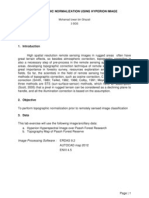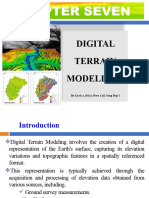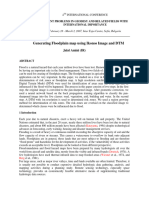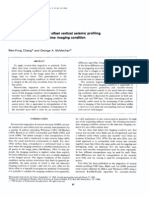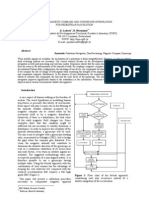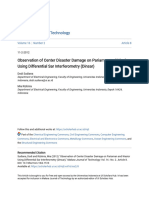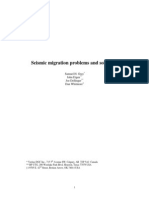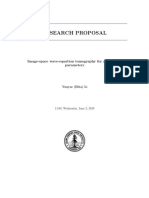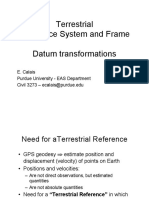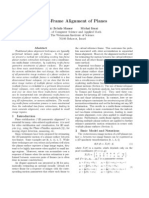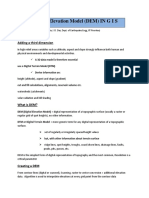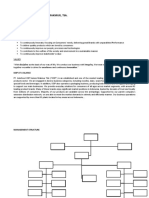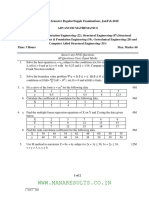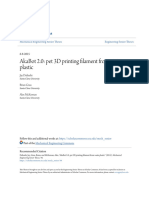Map Migration
Map Migration
Uploaded by
sheriogeoCopyright:
Available Formats
Map Migration
Map Migration
Uploaded by
sheriogeoOriginal Description:
Copyright
Available Formats
Share this document
Did you find this document useful?
Is this content inappropriate?
Copyright:
Available Formats
Map Migration
Map Migration
Uploaded by
sheriogeoCopyright:
Available Formats
14.
1
Map Migration
Map
Migration
Map Migration
What is map migration?
What forms does it take?
When should we use it?
14.2
Map Migration
Depth conversion takes three forms:
Vertical scaling, for flat lying strata (or when the seismic
data have been depth migrated and scaled back to time) -
this is what we have considered so far.
Image ray migration for 3D time migrated data.
Normal incidence ray migration for stacked
(unmigrated) data or 2D grids of time migrated data - after
demigration of the picks.
Ray migration can take place in 2D as event migration on a
line-by-line basis, or in 3D as map migration.
Map Migration
Depth
scaling
Macro-
velocity
model
Normal
incidence
migration
Depth maps
Image
ray
migration
Seismic
horizon
times
Well
Velocity
Z.O. or
image ray
modelling
Compare
Seismic
Velocities
Analytic
functions
Velocity
Maps
Calibrate
14.3
Map Migration
Depth scaling works well in the presence of small structural
dips (less than 10) or when the seismic events are in their
correct lateral position from depth migration.
In the former case we need to know when depth scaling is
inadequate and event (2D) or map (3D) migration is required.
Depth Scaling
Map Migration
For 3D time migrated data the need for map migration is not
obvious since there are no misties in the data when we make
our interpretation. For such data image ray migration is
adequate for intermediate dips ( say 10 to 25).
For image ray maps, i.e. maps made from time migrated
sections, the need for map migration will become obvious in
the case of 2D data as misties manifest themselves in areas
of steeper dip.
For 2D data the usual approach is to demigrate the
interpreted events, using migration velocities, in order to
create a normal incidence map which is then migrated.
Map Migration
14.4
Map Migration
In the case of 2D data misties are caused by sideswipe.
Image ray migration will not overcome the problem, but
demigration of the 2D profiles to form a normal incidence
map, followed by map migration, will solve the problem.
Image ray lies within the
plane of the seismic
section.
Image ray does not
lie within the plane of
the seismic section.
Image Ray Bending
Seismic line
Reflector
Map Migration
Ray migration is a recursive process, i.e. we have to migrate
one layer at a time. The first layer, however, needs no
migration, the ray path is vertical. it is sufficient to depth scale
the image ray structure-in-time map.
We have to:
determine the direction of the image ray in the second
layer, according to Snells law,
ray trace to find where it intersects the second horizon,
depth convert along the ray path and then remap the
second horizon.
The process is then repeated for horizon three, and so on.
Image Ray Migration
14.5
Map Migration
We can estimate the need for map migration:-
Lateral positioning error is estimated by:
x
m
- x t
2
Sin
1
(V
1
- V
2
)(1 + 3Tan
2
)
Where
Tan
1
V
1
dt
1
/dx
1
Tan V
RMS
dt
2
/dx
2
For multiple layers:
Find
1
Tan
-1
( V
A1
dt
1
/dx
1
)
1i
= angle of incidence
Find angle of refraction
1r
(Sin
-1
(V
2
Sin
1i
/V
1
)
Displacement at 2
nd
layer V
2
t
2
tan(
1r
-
1i
)
Find
2
Tan
-1
( V
A2
dt
2
/dx
2
)
Angle of incidence
2i
2
+ (
1r
-
1i
)
Find angle of refraction
2r
(Sin
-1
(V
3
Sin
2i
/V
2
)
Etc.
x
t
2
1
V
1
V
2
x
m
x
t
2
dt
2
/dx
2
dt
1
/dx
1
Image Ray Migration
Map Migration
The need for image ray map migration :-
Two seismic
lines with their tie
positions
marked.
Data courtesy of Amoco
Image Ray Migration
14.6
Map Migration
The need for image ray map migration :-
The two ties made
vertically showing
the misties.
One section is
pivoted about the tie
position until the
dipping horizons of
interest tie.
Data courtesy of Amoco
Image Ray Migration
Map Migration
Data courtesy of Amoco
Approximating map
migration:
One section is pivoted about
the tie position until the
dipping horizons of interest
tie.
The lateral displacement is
annotated on the map.
The procedure is repeated
on the other line
Image Ray Migration
14.7
Map Migration
The two measured displacements are the approximate
components of the Map Migration vector: -
Surface line
positions
Displacement
Displacement
Approximate
Map Migration
Vector
Image Ray Migration
Map Migration
Do exercise 14.1 on the next page.
Image Ray Migration
Map Migration
The seismic lines on the next two sheets tie at the location marked by the heavy line.
Use the technique described earlier to investigate the approximate map migration
vectors at different seismic reflection times.
Draw a series of sketches below to illustrate the vectors at the different depths.
Explain your observations.
Exercise 14.1
14.8
Map Migration Exercise 14.1
14.9
Map Migration
14.10
Exercise 14.1
This page intentionally left blank
Map Migration
14.11
Exercise 14.1
Map Migration
14.12
Exercise 14.1
This page intentionally left blank
14.13
Map Migration
The need for image ray
migration is greatest where
we have a structure beneath
a strongly dipping
overburden which contains
high velocity contrasts.
1 km
2 km
1 km
2900
2600
4350
4
7
0
0
5
4
0
0
5200
5
0
0
0
5100
4550
Example after Larner et al, Depth migration of imaged
time sections, Geophysics, May 1981
Image Ray Migration
Map Migration
Migrated depth map
with displacement
vectors and the
before and after
fault positions.
From a Paradigm Geophysical brochure.
Image Ray Migration
14.14
Map Migration
For normal incidence maps we can estimate the effects of
migration as follows:-
x
z
d
x
d
z
t
Depth error
d
z
= d
T
/ V
RMS
where d
T
is the vertical time
displacement given by
d
T
= T{1 - [1 - (V
RMS
2
.tan
2
)/4]
1/2
}.
The horizontal displacement is
d
x
= (V
RMS
2
T.tan)/4,
tan = T / x (time dip) from the
unmigrated section,
T the two way time to the reflector.
Normal Incidence Migration
See Chun and Jacewitz 1981 for full details
Map Migration
As with image ray migration, normal incidence ray migration
is a recursive process, but this time, we need to migrate the
first horizon.
Last
horizon?
No
Time
picks
Velocities
Emergence
angle for
horizon
Time dip
for horizon
Migrate to
depth by
ray tracing
Next layer
Final model Yes
Normal Incidence Migration
14.15
Map Migration
The rays are traced into a
layer for a distance given by
L = T
o
x velocity / 2
starting at an emergence
angle given by
sin = time dip x V
e
/ 2.
The local time dip of the
event is given by
tan = t / x
V
e
is the velocity with which
the ray emerges from the
layer.
T
X
V
1
V
i
= V
0
+ Kz
V
O
t
x
T
o
T
o
Normal Incidence Migration
Map Migration
Migrated depth map with
displacement vectors and
the before and after fault
positions.
From Sattlegger GmbH brochure.
Normal Incidence Migration
14.16
Map Migration
Ray Migration
Image ray migration is most sensitive
to errors in velocity, and hence errors
in angles.
Normal incidence migration is most
sensitive to the emergence angle
which depends on velocity gradient
and surface dip.
Map Migration
Summary
Vertical scaling is adequate when dips are less than 10.
Image ray map migration is adequate for dips between about
10 and 25 with 3D time migrated data.
For 2D time migrated data with dips over 10 and 3D time
migrated data with dips over ~25 use normal incidence map
migration.
14.17
Map Migration
Summary
Stability
Dip
Handling
High Low (<10)
Depth
Scaling
Medium
Low
Medium
(10 - 20)
Image
Ray
Migration
High
(> 20)
NI
Ray
Migration
Map Migration
Map Migration
Integration
Analytic
functions
/ Mapping
Depth
scaling
Average,
Interval,
Instantaneous
Macro-
velocity
model
Image Ray
migration
Depth maps
NI Ray
migration
Seismic
horizon
times
Velocity log
Sonic log
Checkshot
or VSP
Z.O. or
image ray
modelling
Compare
Seismic
Velocities
Dip,
Interpolation
Invert
(Dix/Bias)
Edit,
Smooth
Calibrate
14.18
Map Migration
Summary
Stack
Conventional
Processing
Time
Migration
Stacking /
Time migration
Velocity
Calibrated
Velocities
Horizon
Picks
Well
Data
Macrovelocity
Model
Depth
Scale / Map
Migrate
Forward
Model
Map Migration
Map Migration
Exercise: compute the image ray bending.
In the following model the reflection times and time dips are observed on a time
migrated dip section at the flank of a salt dome and the interval velocities come
from a nearby well. You do not have map migration software available.
Should you consider map migration to depth convert the 4th event (the target
horizon)?
Hint: Find the average velocity down to each event, convert the time dips into
structural dips and then compute the lateral displacement of the image ray at
each interface.
0
720
1145
1315
1870
TWT msec
V
I
= 6760 ft/s
V
I
= 7246 ft/s
V
I
= 8130 ft/s
V
I
= 8889 ft/s
time dip = 400 msec over 280 traces
time dip = 400 msec over 230 traces
time dip = 400 msec over 220 traces
time dip = 500 msec over 30 traces
trace spacing = 75 ft.
Exercise 14.2
14.19
You might also like
- Motel 6 Discount Motel Rooms - Budget Motel - by Motel 6Document2 pagesMotel 6 Discount Motel Rooms - Budget Motel - by Motel 6Mario ChávezNo ratings yet
- Athena Cycles: Author Date PurposeDocument11 pagesAthena Cycles: Author Date PurposeJacob Sheridan100% (2)
- Topographic Normalization LabDocument7 pagesTopographic Normalization LabsatoruheineNo ratings yet
- Depth Conversion of Post Stack Seismic Migrated Horizon Map MigrationDocument11 pagesDepth Conversion of Post Stack Seismic Migrated Horizon Map MigrationhimanshugstNo ratings yet
- FB Tutorial Migration Imaging Conditions 141201Document11 pagesFB Tutorial Migration Imaging Conditions 141201Leonardo Octavio Olarte SánchezNo ratings yet
- Seiemic Velocity For Time MigrationDocument42 pagesSeiemic Velocity For Time MigrationTuan-Anh Xuan NghiemNo ratings yet
- 5 Migration PDFDocument12 pages5 Migration PDFel_toritoNo ratings yet
- 27 DFDocument4 pages27 DFPAUL RODRIGUEZNo ratings yet
- Digital Terrain Analysis With IlwisDocument15 pagesDigital Terrain Analysis With IlwisVictor Okech100% (1)
- PE20M002 Seismic MigrationDocument18 pagesPE20M002 Seismic MigrationNAGENDR_006No ratings yet
- Sep 20-2022 Tuesday, CH 12 (4-5) Curvilinear Motion X-Y CoordinateDocument41 pagesSep 20-2022 Tuesday, CH 12 (4-5) Curvilinear Motion X-Y CoordinateSuhaib IntezarNo ratings yet
- Depth Conversion of Time InterpretationsDocument58 pagesDepth Conversion of Time InterpretationsAyu Indri FirdaniNo ratings yet
- Digital Elevation Models (DEM)Document14 pagesDigital Elevation Models (DEM)mike07No ratings yet
- Astr211: Assignment 4Document12 pagesAstr211: Assignment 4jacobNo ratings yet
- An Overview of SAR InterferometryDocument15 pagesAn Overview of SAR InterferometrySanjoy BasakNo ratings yet
- Depth Conversion of Time Interpretations Volume ModelsDocument53 pagesDepth Conversion of Time Interpretations Volume ModelsSani TipareNo ratings yet
- Chapter SevenDocument30 pagesChapter Seveneyoba2590No ratings yet
- The Deltatv 1D Method For Seismic Refraction Inversion: TheoryDocument20 pagesThe Deltatv 1D Method For Seismic Refraction Inversion: TheoryAyubUnvedNo ratings yet
- Migration of Common-Shot Gathers: Moshe Reshef and Dan KosloffDocument8 pagesMigration of Common-Shot Gathers: Moshe Reshef and Dan KosloffsputriNo ratings yet
- Attenuation of Diffracted Multiples With An Apex-Shifted Tangent-Squared Radon Transform in Image SpaceDocument14 pagesAttenuation of Diffracted Multiples With An Apex-Shifted Tangent-Squared Radon Transform in Image Spacemohamed_booksNo ratings yet
- Surveying2 Exam Note (JAN 18) : Vertical Curve FormulasDocument5 pagesSurveying2 Exam Note (JAN 18) : Vertical Curve FormulaslucasNo ratings yet
- Localized Feature ExtractionDocument6 pagesLocalized Feature ExtractionsujithaNo ratings yet
- Insar Dem Why It Is Better?Document8 pagesInsar Dem Why It Is Better?Percy PeraltaNo ratings yet
- Radon TransformDocument9 pagesRadon TransformKonglomerate0% (1)
- Vdocuments - MX TdefnodeDocument67 pagesVdocuments - MX TdefnodeamarNo ratings yet
- Dem TheoryDocument8 pagesDem TheoryAbdirahmanNo ratings yet
- Amini IkonosandfloodDocument8 pagesAmini IkonosandfloodrjgarnicapNo ratings yet
- Anisotropic Velocity Analysis: Panorama TechnologiesDocument16 pagesAnisotropic Velocity Analysis: Panorama TechnologiesdelapanvideoNo ratings yet
- Genetic and ICP Laser Point Matching For 2D Mobile Robot Motion EstimationDocument23 pagesGenetic and ICP Laser Point Matching For 2D Mobile Robot Motion EstimationhenrydclNo ratings yet
- Wa0011.Document10 pagesWa0011.dacchu0402No ratings yet
- Sliced Ridgelet Transform For Image DenoisingDocument5 pagesSliced Ridgelet Transform For Image DenoisingInternational Organization of Scientific Research (IOSR)No ratings yet
- ECE2022-Lecture 2P1-Particle Kinematics - Motion Along A Straight LineDocument85 pagesECE2022-Lecture 2P1-Particle Kinematics - Motion Along A Straight LineDuchin AnNo ratings yet
- Reverse-Time Migration of Offset Vertical Seismic Profiling Data Using The Excitation-Time Imaging ConditionDocument18 pagesReverse-Time Migration of Offset Vertical Seismic Profiling Data Using The Excitation-Time Imaging ConditionjfungjNo ratings yet
- Image Encryption and Decryption Using Radon Transform For Information SecurityDocument7 pagesImage Encryption and Decryption Using Radon Transform For Information SecurityJournal Home e-PublicationNo ratings yet
- Group 6 - Seismic MigrationDocument21 pagesGroup 6 - Seismic MigrationKwame PeeNo ratings yet
- 3rd WeekDocument7 pages3rd WeekNanzkie Andrei SamanNo ratings yet
- Seismic MigrationDocument48 pagesSeismic Migrationniksr91100% (2)
- 2 - Volumetric Dip and AzimuthDocument20 pages2 - Volumetric Dip and AzimuthSagnik Basu RoyNo ratings yet
- Rectilinear Texture Warping For Fast Adaptive Shadow MappingDocument3 pagesRectilinear Texture Warping For Fast Adaptive Shadow Mappingm_hasani9702No ratings yet
- Digital Magnetic Compass and Gyroscope IntegrationDocument10 pagesDigital Magnetic Compass and Gyroscope IntegrationJosé Fernando Velázquez DamiánNo ratings yet
- Observation of Center Disaster Damage On Pariaman and Wasior UsinDocument6 pagesObservation of Center Disaster Damage On Pariaman and Wasior UsinDodi SudianaNo ratings yet
- An Image Fusion Using Wavelet and Curvelet TransformsDocument5 pagesAn Image Fusion Using Wavelet and Curvelet TransformsajayroyalNo ratings yet
- 10 - Depth Conversion and Depth ImagingDocument44 pages10 - Depth Conversion and Depth Imagingreqech100% (1)
- Migration&Pstm LKDocument75 pagesMigration&Pstm LKPallav KumarNo ratings yet
- Seismic MigrationDocument77 pagesSeismic Migrationnaivedya_mishra100% (2)
- Dapus 1 PDFDocument45 pagesDapus 1 PDFUkhty Thiyyu SaiianqBundaNo ratings yet
- Interferometric Synthetic Aperture Radar - Wikipedia, The Free EncyclopediaDocument9 pagesInterferometric Synthetic Aperture Radar - Wikipedia, The Free EncyclopediakowsilaxNo ratings yet
- 1proposal StanfordDocument23 pages1proposal StanfordGM BorisNo ratings yet
- LSD-SLAM: Large-Scale Direct Monocular SLAMDocument16 pagesLSD-SLAM: Large-Scale Direct Monocular SLAMRamprasadNo ratings yet
- Optical Flow (Motion Vector) ComputationDocument18 pagesOptical Flow (Motion Vector) Computationngocbienk56No ratings yet
- Mapping Contoured Terrain - A Comparison of SLAM Algorithms For RAdioControlled HelicoptersDocument32 pagesMapping Contoured Terrain - A Comparison of SLAM Algorithms For RAdioControlled HelicoptersGeoFurrielNo ratings yet
- Terrestrial Reference System and FrameDocument34 pagesTerrestrial Reference System and FrameArga Fondra OksapingNo ratings yet
- Multi-Frame Alignment of Planes: Lihi Zelnik-Manor Michal IraniDocument6 pagesMulti-Frame Alignment of Planes: Lihi Zelnik-Manor Michal IraniQuách Thế XuânNo ratings yet
- E023 Generalizations of The Common-Reflection-Surface StackDocument4 pagesE023 Generalizations of The Common-Reflection-Surface Stack828391No ratings yet
- 24may2017 Arpit DEM HydroDocument66 pages24may2017 Arpit DEM HydroAnonymous 1n3A5CNo ratings yet
- Digital Terrain ModelingDocument37 pagesDigital Terrain ModelingLionKingNo ratings yet
- Creating Depth Images From Seismic Records: Surface of EarthDocument15 pagesCreating Depth Images From Seismic Records: Surface of Earthforscribd1981No ratings yet
- WATERMARKING: It Is Nothing But Adding Information To An Object About ItDocument12 pagesWATERMARKING: It Is Nothing But Adding Information To An Object About ItShobhit GoswamiNo ratings yet
- InsarDocument12 pagesInsarPercy PeraltaNo ratings yet
- Digital Elevation Model (DEM) IN G I S: Adding A Third DimensionDocument7 pagesDigital Elevation Model (DEM) IN G I S: Adding A Third DimensionAkash BadoniNo ratings yet
- Management Structure Indofood CBPDocument2 pagesManagement Structure Indofood CBPdwihitaNo ratings yet
- Serving Mining Industries and Civil Engineering Projects of India and Abroad, Since 2002Document48 pagesServing Mining Industries and Civil Engineering Projects of India and Abroad, Since 2002Amrik Singh PahwaNo ratings yet
- (PC) Yonai v. Teaford Et Al - Document No. 3Document2 pages(PC) Yonai v. Teaford Et Al - Document No. 3Justia.comNo ratings yet
- Exploratory Research Design: Qualitative ResearchDocument27 pagesExploratory Research Design: Qualitative ResearchPrakash Sharma100% (3)
- Assignment 4 DT NB LR SolutionDocument5 pagesAssignment 4 DT NB LR SolutionYvette SuNo ratings yet
- 04 Solar Power Experiment and Equations Mack Grady Sept 20 2012Document26 pages04 Solar Power Experiment and Equations Mack Grady Sept 20 2012AbdussalamElhanashiNo ratings yet
- M.Tec Maths Quation PaperDocument2 pagesM.Tec Maths Quation Papersri10888No ratings yet
- FMDocument14 pagesFMJorge Gonzalez LopezNo ratings yet
- dr135 mk2Document60 pagesdr135 mk2zaenal abidinNo ratings yet
- Tamilnadu Newsprint and Papers Limited: Sl. No. Name of The Posts No. of Posts Reservation Scale of Pay / Monthly CTCDocument8 pagesTamilnadu Newsprint and Papers Limited: Sl. No. Name of The Posts No. of Posts Reservation Scale of Pay / Monthly CTCV. Krishna ThejaNo ratings yet
- AkaBot 2.0 - Pet 3D Printing Filament From Waste PlasticDocument120 pagesAkaBot 2.0 - Pet 3D Printing Filament From Waste Plasticpissoff69No ratings yet
- Capital Structure Decisions in Financial ManagementDocument52 pagesCapital Structure Decisions in Financial ManagementAnkit LakhaniNo ratings yet
- BP - Electrical System With Extreme ConditionsDocument17 pagesBP - Electrical System With Extreme Conditions----No ratings yet
- HP - Strong Buy: HP Lowers The BarDocument5 pagesHP - Strong Buy: HP Lowers The BarChetan AgarwalNo ratings yet
- SCMIntro 2023Document43 pagesSCMIntro 2023Neko MidoriNo ratings yet
- Common Issues of BGPDocument7 pagesCommon Issues of BGPPranavNo ratings yet
- The Colorist Guide To DaVinci Resolve 18 - PART - 2Document195 pagesThe Colorist Guide To DaVinci Resolve 18 - PART - 2Vinay AradhyaNo ratings yet
- Algorithm For Cubature Kalman FilterDocument23 pagesAlgorithm For Cubature Kalman FilterKaterina PapadopoulouNo ratings yet
- Fire Stopping Standard DetailsDocument78 pagesFire Stopping Standard DetailsRoger ChetcutiNo ratings yet
- Institute Name: Indian Institute of Technology Hyderabad (IR-O-U-0013)Document14 pagesInstitute Name: Indian Institute of Technology Hyderabad (IR-O-U-0013)Zain RashidNo ratings yet
- Carrer Prospect of HRDocument11 pagesCarrer Prospect of HRmanagement 149No ratings yet
- Whirlpool WED5605MWDocument1 pageWhirlpool WED5605MWalNo ratings yet
- Hsslive-XII Acc - CA - Focus Area Notes 2022 - All Chapters - Ajith KanthiDocument40 pagesHsslive-XII Acc - CA - Focus Area Notes 2022 - All Chapters - Ajith KanthisnigdhaNo ratings yet
- 1561 1599Document12 pages1561 1599WesNo ratings yet
- Entrepreneur Innovation (Tan Sri A.K. Nathan)Document12 pagesEntrepreneur Innovation (Tan Sri A.K. Nathan)Thava Selvy100% (1)
- My Personal Mission Statment - Always UpdateDocument8 pagesMy Personal Mission Statment - Always UpdateChristian Dominic MarayagNo ratings yet
- Important Medicinal and Aromatic Plants in South East Europe in Relation With Their Medicinal and Other Industrial Utilization Republic of MacedoniaDocument41 pagesImportant Medicinal and Aromatic Plants in South East Europe in Relation With Their Medicinal and Other Industrial Utilization Republic of MacedoniaOana Sidor100% (1)
- Marketing Management Book - 1Document328 pagesMarketing Management Book - 1sameerkh2305No ratings yet


